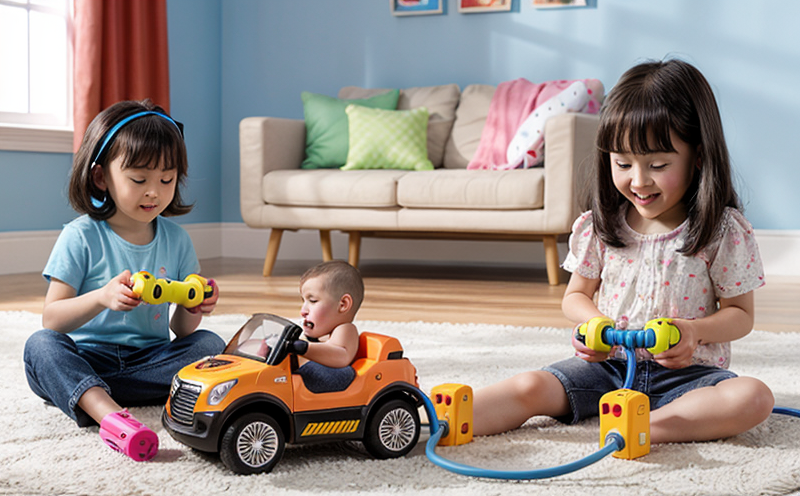ASTM F963 Battery Ingestion Safety Test
The ASTM F963-17 Standard Consumer Safety Specification for Toy Safety is one of the most comprehensive toy safety standards available. Among its various requirements, it includes a section specifically addressing battery ingestion hazards in electrical and battery-operated toys. The ASTM F963 Battery Ingestion Safety Test ensures that batteries within toys are designed to prevent accidental ingestion by children.
This test aims to evaluate whether the design of toy batteries is such that they can be easily removed from their enclosures, which could lead to ingestion if not properly secured. Compliance with this test is crucial for manufacturers and importers who wish to ensure their products meet international safety standards. The ASTM F963 Battery Ingestion Safety Test involves a series of steps designed to simulate real-world scenarios where a child might access the battery compartment.
The test procedure typically includes:
- Identifying toys that contain batteries and assessing the ease with which these batteries can be removed.
- Using standardized tools or techniques to attempt removal of the battery from its enclosure under controlled conditions.
- Evaluating the battery’s shape, size, and other characteristics that could pose a choking hazard if ingested by children.
- Documenting any findings regarding the ease of access and potential risk levels associated with each toy model tested.
The test is particularly important for toys intended for younger children, as they are more likely to explore and play with small components that could be easily detached. Compliance with ASTM F963 helps manufacturers design safer products by ensuring that there are no parts of the toy that can be removed or accessed in a way that poses a risk.
For quality managers and compliance officers, this test is essential for ensuring product safety and avoiding legal issues associated with non-compliance. R&D engineers involved in designing electrical toys need to consider these standards during the early stages of product development to avoid costly redesigns later on. Procurement teams must also ensure that components used meet these stringent requirements.
ASTM F963 is not just a set of guidelines; it’s an enforceable standard recognized globally, which means compliance is non-negotiable for businesses operating in the toy industry. The test ensures that toys are safe from ingestion hazards and meets international safety standards. By adhering to ASTM F963 Battery Ingestion Safety Test procedures, manufacturers can demonstrate their commitment to child safety.
Applied Standards
| Standard | Description |
|---|---|
| ASTM F963-17 Standard Consumer Safety Specification for Toy Safety | This standard includes requirements to ensure that batteries within toys are designed to prevent accidental ingestion by children. |
| IEC 62104-1:2008 Safety of Toys - Part 1: General Requirements | This international standard provides general safety requirements for toys, which includes considerations for battery design and child safety. |
The ASTM F963 Battery Ingestion Safety Test is directly aligned with the specific requirements outlined in ASTM F963-17. This test ensures that toy manufacturers comply with international standards aimed at protecting children from potential hazards associated with battery ingestion.
Benefits
Ensures compliance with ASTM F963 and other relevant safety standards, reducing the risk of product recalls and legal disputes.
Reduces the likelihood of accidental injuries or fatalities due to battery ingestion in children.
Improves brand reputation by demonstrating a commitment to child safety and regulatory compliance.
Promotes safer toy design, encouraging innovation that prioritizes child safety without compromising functionality.
The ASTM F963 Battery Ingestion Safety Test is not just about meeting legal requirements; it also enhances the overall quality of toys by identifying potential hazards early in the development process. This proactive approach can lead to safer, more reliable products that gain consumer trust and loyalty.
Industry Applications
| Industry Sector | Description |
|---|---|
| Toys & Games | This test is crucial for toy manufacturers, especially those targeting younger children. |
| Retail | Retailers must ensure that all toys they sell comply with ASTM F963 standards to protect their customers and avoid legal issues. |
Electrical & Battery Operated Toys: This test is particularly important for toys that incorporate batteries, such as remote-controlled cars or talking dolls.
Electronic Toys: For toys with electronic components, ensuring safe battery design and placement is paramount to avoid ingestion hazards.
The ASTM F963 Battery Ingestion Safety Test plays a vital role in the toy manufacturing and retail sectors by providing a standardized method for assessing potential risks associated with batteries. This ensures that toys are not only fun but also safe, contributing to a safer environment for children worldwide.





